
Angkor hidden temples : Banteay Srei, Samre, Roluos
Overwhelmed by crowds at Angkor Wat’s main attractions? Discover the hidden gems of Banteay Srei, Banteay Samre, and the Roluos Group—temple complexes that reveal the Khmer Empire’s artistry and history away from the tourist trail. This guide explores their unique architecture, cultural significance, and practical tips for visiting, offering a quieter, more immersive journey into Cambodia’s ancient past.
Beyond Angkor Wat’s grandeur, Banteay Srei’s intricate carvings, Banteay Samre’s symmetrical elegance, and Roluos Group’s early Khmer masterpieces reveal Cambodia’s cultural depth. Plan your visit to these lesser-known temples for a quieter, immersive journey through sacred architecture and mythology. Their preservation ensures future travelers can continue discovering the artistry that defines Angkor’s legacy.
BANTEAY SREI
Known as the « Citadel of Women » or « Pink Temple, » Banteay Srei is located about 20km northeast of the main Angkor complex. This exquisite temple was built in the 10th century from pink sandstone and consecrated in 967 AD, dedicated to Shiva.
What makes Banteay Srei extraordinary is its intricate and extraordinarily beautiful decoration carved in hard pink sandstone, making it unique in the Angkor region. Unlike most other Cambodian temples, it was built predominantly using red sandstone, which gives its carvings a pleasant and colorful appearance. The distinctly pink sandstone brilliantly catches the morning light.
The temple is miniature in size compared to other temples in the Angkor area, but is famous for its beautiful three-dimensional wall carvings. It’s unique in that it was commissioned not by a king but by courtiers – Yagnavaraha and Vishnukumara, who built it on land granted by King Rajendravarman.
BANTEAY SAMRE
Banteay Samre is perhaps one of the most beautiful of the smaller ancient temple sites, almost rivaling the popular Banteay Srei site. It was built in the early 12th century by Kings Suryavarman II and Yasovarman II and resembles Angkor Wat, looking like a miniature version of the great temple.
Located about 10km northeast of Angkor Wat and near the eastern edge of the ancient East Baray, this Hindu temple was dedicated to Vishnu and built in the style of Angkor Wat. The temple takes its name from the Samre people that inhabited the area, and its pediments and lintels are decorated with very intricate and well-preserved carvings of Hindu mythological stories.
Being somewhat « off the beaten track, » not many people visit Banteay Samre, making it a perfect choice for photography without thousands of other people around. The temple features scenes of Vishnu sitting on Makara, Krishna, the Churning of the Ocean of Milk, and sculptures of Rama and Vishnu on important lintels.
ROLUOS GROUP
The Roluos Group refers to four temples located near the town of Roluos, 12km east of Siem Reap: Bakong, Preah Ko, Lolei, and Prei Monti. These are the oldest of the main Angkor temples, dating from the late 9th century and representing the earliest site of the 600-year Angkor Period open to visitors.
The significance of these temples is that they’re the last remains of Hariharalaya, which was the second capital of the Angkor-era Khmer Empire. The site was an ancient center of Khmer civilization known as Hariharalaya (meaning « the abode of Hari-hara »), established about 70 years after Jayavarman II founded his capital on Mount Kulen in 802 AD.
Bakong is the highlight – the first temple mountain of its style, featuring five levels with a center tower and an impressive height of 15 meters. It was the state temple at the center of Hariharalaya. Preah Ko features six towers with statues of bulls surrounding it, and its name means « sacred bull. » Lolei is unique as an island temple, surrounded by a now-dried man-made reservoir called a baray, featuring four crumbling towers.
The three main temples have similar characteristics of architecture, decoration, materials and construction methods, which combine to reveal the beginning of the Classic Period of Khmer art.
Table of contents
| Period | Event |
|---|---|
| 967 CE | Constructed under guidance of Yajnavaraha and Vishnukumara |
| 1119 CE | Rededicated to Shiva under new ownership |
| 1914 | Rediscovered by French archaeologists |
| 1924-1936 | Initial restoration using anastylosis technique |
| 2001-2006 | Modern conservation by Swiss-Cambodian team |
| 2024 | Ongoing preservation efforts continue |
| Temple | Location & Size | Architectural & Historical Highlights |
|---|---|---|
| Banteay Samre | 18 km from Siem Reap, 10 km from Angkor Wat. 6000 m² outer enclosure, 1800 m² inner enclosure. 20m central tower. | Early 12th century (Suryavarman II/Yasovarman II). Two 6m concentric walls, dry moat. Hindu carvings (Vishnu, Rama vs. Ravana). Restored 1936-1944, ongoing work in 2024. Includes 200m raised entrance causeway. |
| Angkor Wat | Central Angkor complex, 5.5 km from Siem Reap. 162.6 hectares total area. 65m central tower. | Early 12th century (Suryavarman II). Largest religious monument. Moat (190m wide). Three-tiered structure with bas-reliefs. Dedicated to Vishnu. UNESCO World Heritage Site. Most visited temple. |
| Banteay Srei | 25 km northeast of Angkor Wat. Small structure (approx. 24m x 24m). Built on elevated terrain. | 967 CE (Rajendravarman II). Pink sandstone construction. Dedicated to Shiva. Renowned for intricate carvings and « Citadel of Women » nickname. Rediscovered in 1914. Part of Grand Circuit ticket. |
| Roluos Group | 12 km from Siem Reap. Preah Ko (14m tower), Bakong (15m pyramid), Lolei (island temple). | 879-899 CE (Indravarman I). Earliest Khmer sandstone temple (Preah Ko). Bakong as first pyramid temple. Lolei predates Angkor Wat by 150 years. Original wooden structures replaced with sandstone. |
FAQs About the Tours
Any question ?
What is the dress code for these temples ?
The dress code for visiting temples like Angkor Wat, Banteay Srei, Banteay Samre, and the Roluos group requires visitors to cover their shoulders and knees. This applies to both men and women, ensuring respect for the spiritual traditions associated with these sacred sites.
Specifically, tank tops, shorts above the knee, and skirts above the knee are not permitted. If clothing doesn’t cover the shoulders, a shawl or scarf can be used. It is advisable to wear loose-fitting clothing made of breathable materials due to the hot and humid climate. Comfortable shoes are also recommended.
How many temples are in the Roluos Group ?
The Roluos Group consists of four main temples: Bakong, Lolei, Preah Ko, and Prei Monti. These temples are remnants of Hariharalaya, the first capital of the Khmer Empire during the Angkorian period, marking the beginning of the classical period of Khmer civilization.
While some sources mention only three main temples (Bakong, Lolei, Preah Ko), most include Prei Monti as part of the Roluos Group, making it generally considered to comprise four temples.
03
What is the best time to visit these temples ?
The best time to visit the temples of Angkor is from November to March, during the cooler and drier months. However, this period is also the busiest. It is advisable to visit early in the morning (5 AM) or later in the afternoon (4 PM) to avoid crowds and enjoy a more peaceful experience.
The period from June to October is hotter and more humid, with afternoon showers, but it is also less crowded. Mornings are the best time to explore the temples during this period. If you only have one day, consider reversing the typical tourist schedule to avoid the largest crowds.
How much does it cost to visit these temples ?
The entrance fees for visiting the temples of Angkor vary depending on the chosen pass: a 1-day pass costs $37 USD, a 3-day pass costs $62 USD, and a 7-day pass costs $72 USD. These passes allow access to the temples within the Angkor Archaeological Park, including peripheral sites such as Beng Mealea, Chau Srei Vibol, Kbal Spean, and Banteay Srei, as well as the Roluos Group.
Children under 12 years old do not need to purchase an entrance ticket, provided they present their passport. A portion of the ticket price ($2 USD) is donated to the Kantha Bopha Children’s Hospital fund. Passes can be purchased at the Angkor Ticket Office or online.
05
How far are these temples from each other ?
It’s challenging to provide exact distances between all the mentioned temples, but here are some general indications. Siem Reap, the closest city to the temples, is 8 km from the first temples of Angkor. There can be several kilometers between each temple.
The Roluos complex is located approximately 12 km southeast of Angkor, while Banteay Srei is situated 37 km north of Angkor. Banteay Samre is located north of the Angkor Archaeological Park, 21.1 km from Banteay Srei. It is advisable to use transportation such as an air-conditioned car with a driver, tuk-tuk, motorcycle taxi, or bicycle to travel between the temples.
Expert Team
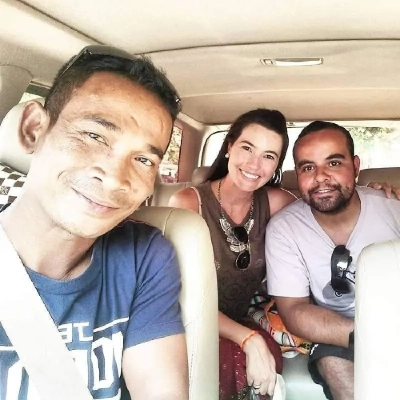
Kim Hak
MiniVan Driver
Hello Dear Valued Visitor !
My name is Kim Hak, and I’m a local Cambodian driver specializing in tourist services in Siem Reap, Cambodia. I drive a Grand Starex and offer taxi services and tours to all 25 provinces and cities (24-hour service available).
I am an experienced driver who has been driving since 2006, and I can speak English and Mandarin.
I love providing recommendations for interesting places in Siem Reap and showing my customers the best parts of Cambodia. I will ensure that my customers are well taken care of, safe, and have the best travel experience while visiting Siem Reap, Cambodia.
I look forward to showing you around Siem Reap, Cambodia! =)
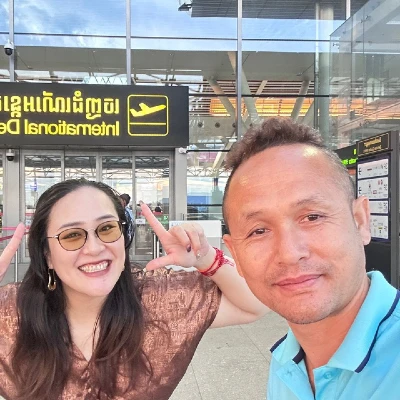
Sophara
Car Driver
Greetings, travelers! I’m Sophara, your friendly local guide and driver based in Siem Reap, Cambodia. With my comfortable SUV and Grand Starex vehicles, I’m ready to take you on unforgettable journeys throughout Cambodia’s 25 provinces and cities, any time of day or night.
Since 2008, I’ve been passionate about sharing the wonders of my beautiful country with visitors from around the world. Speaking both English and Mandarin, I bridge cultures while creating meaningful travel experiences.
I specialize in creating customized adventures that reveal both Cambodia’s famous landmarks and its best-kept secrets.. Your safety, comfort, and satisfaction are always my top priorities.
Ready to explore Cambodia with a local who truly cares about making your trip extraordinary? Let’s create amazing memories together!
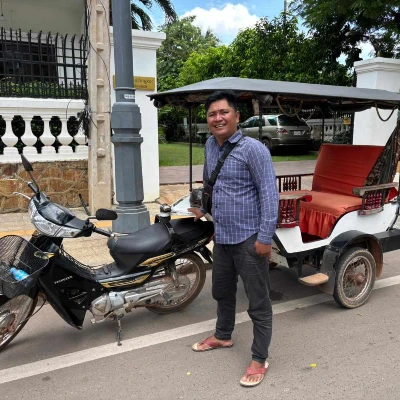
Mister Ra
Tuk-Tuk Driver
Hello there ! I’m Mister Ra, your local tuk-tuk driver and guide in Siem Reap, Cambodia. With my reliable tuk-tuk, I specialize in exploring the magnificent Angkor Wat temple complex and providing comprehensive city tours around Siem Reap.
For nearly two decades, I’ve been showing visitors the incredible temples of Angkor and the vibrant streets of our beautiful city. Speaking English fluently, I enjoy sharing stories and connecting with travelers from all corners of the world
Ready to explore Siem Reap’s treasures with a local who’s passionate about sharing his hometown? Let’s create some amazing memories together !
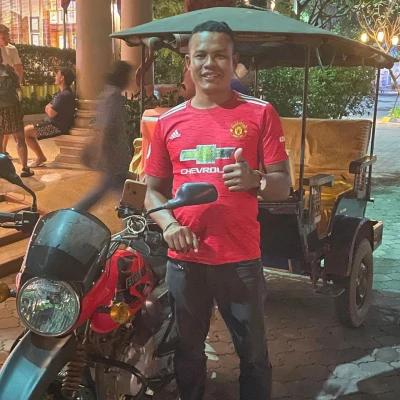
Chom
Tuk-Tuk Driver
Greetings, fellow travelers !
I’m Chom, your friendlyTuk-Tuk Driver here in Siem Reap, Cambodia.
With my reliable Tk-Tuk, I’ve been serving visitors since 2016, offering transportation and tours throughout Angkor Wat and beyond
Your comfort, security, and satisfaction are my personal mission. Every trip is designed to exceed expectations while respecting your time and budget.
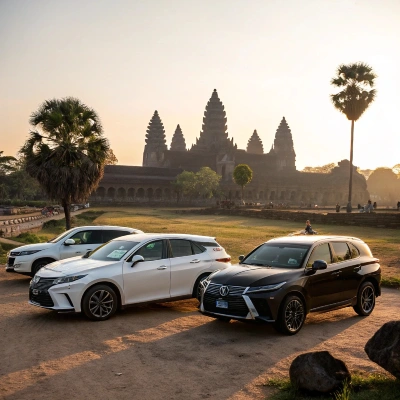
More CARS, More TUKTUK
if needed
Don’t worry we will have many other solutions when we will be fully-booked
We have many friends or relatives to call when needed
Only professional people of course